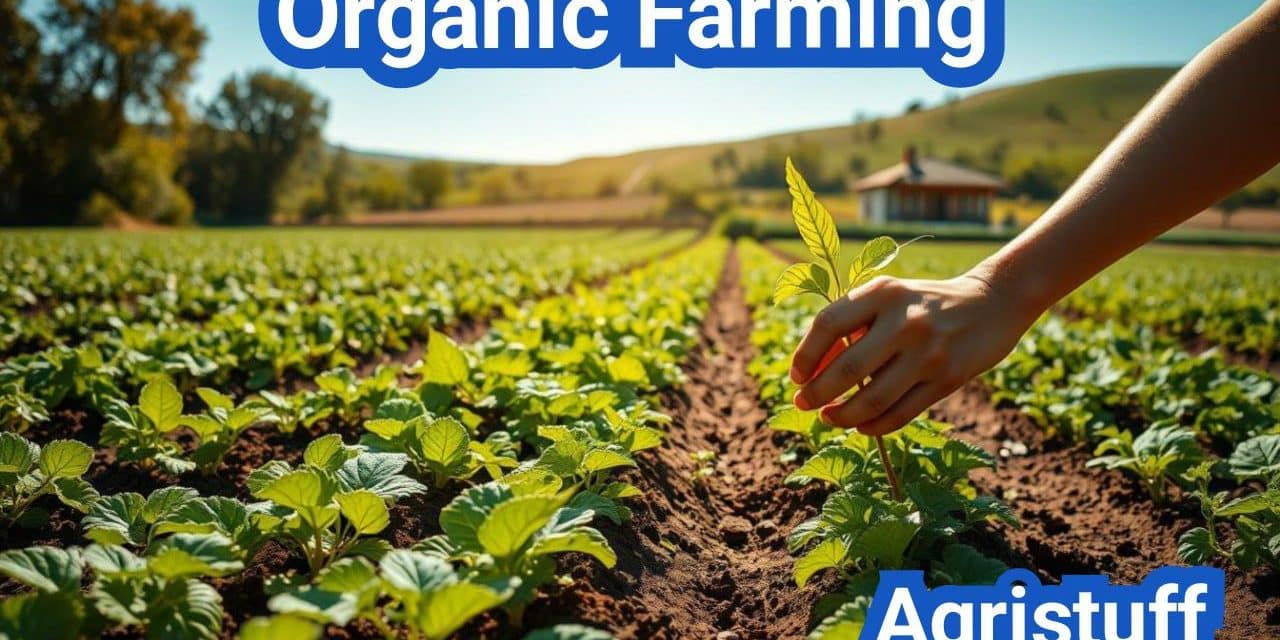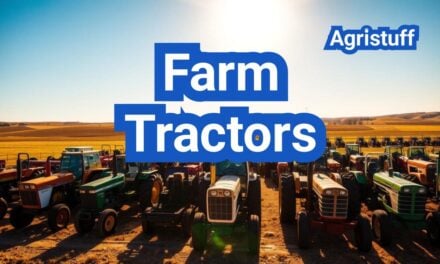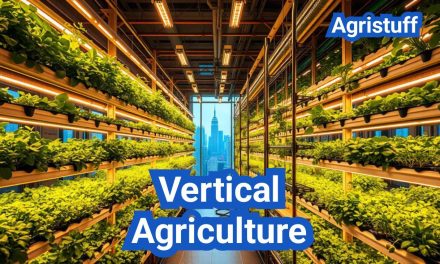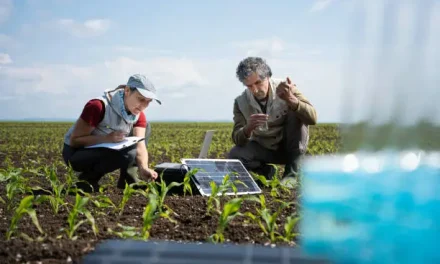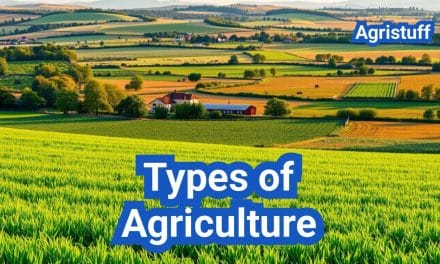Organic farming practices have gained significant attention in recent years due to their potential to promote ecological balance and conserve biodiversity.
Organic farming is a method of cultivating crops and raising livestock without the use of synthetic fertilizers, pesticides, or genetically modified organisms, as per the USDA organic standards.
This approach to agriculture not only ensures the production of healthy food but also contributes to a more sustainable environment. By adopting organic farming methods, farmers can reduce their environmental footprint and promote a healthier ecosystem.
Key Takeaways
- Understanding the principles of organic farming and its benefits.
- Exploring the USDA organic standards and their significance.
- Learning about the environmental benefits of sustainable farming practices.
- Discovering the importance of eco-friendly agriculture.
- Recognizing the role of organic farming in promoting biodiversity.
What Is Organic Farming?
The essence of organic farming lies in its holistic approach to agriculture, focusing on ecological balance and biodiversity. This method of farming is designed to work with natural processes, enhancing the health of the soil, plants, animals, and people.
Core Principles and Philosophy
Organic farming is grounded in several core principles that guide its practices. These include:
- Ecological Balance: Maintaining the health of ecosystems by promoting biodiversity and efficient water use.
- Soil Conservation: Enhancing soil fertility through natural means like composting and crop rotation.
- Minimal External Inputs: Reducing the reliance on external inputs, such as synthetic fertilizers and pesticides.
These principles are rooted in a philosophy that sees farming as part of a larger ecological system, where the health of one aspect affects the whole.
Key Differences from Conventional Agriculture
Organic farming diverges from conventional agriculture in several significant ways:
- Avoidance of Synthetic Chemicals: Organic farming prohibits the use of synthetic fertilizers, pesticides, and genetically modified organisms (GMOs), which are commonly used in conventional farming.
- Focus on Soil Health: Organic practices prioritize building soil health through methods like composting and cover cropping, unlike conventional farming which may rely on synthetic fertilizers.
- Diverse Crop and Animal Systems: Organic farming often incorporates diverse crop rotations and integrates livestock, enhancing biodiversity and ecological services.
Understanding the principles and practices of organic farming is crucial for appreciating its potential to contribute to a more sustainable food system. By focusing on ecological balance and avoiding synthetic chemicals, organic farming offers a distinct alternative to conventional agricultural methods.
The History and Evolution of Organic Farming

The organic movement emerged as a response to the industrialization of agriculture, seeking to promote more sustainable farming practices. This shift was driven by concerns over the environmental and health impacts of conventional farming methods.
Origins of the Organic Movement
The early 20th century marked the beginning of the organic movement, as farmers and scientists started questioning the use of synthetic fertilizers and pesticides. Pioneers like Sir Albert Howard and Lady Eve Balfour were instrumental in promoting organic practices through their research and advocacy.
“The maintenance of soil fertility is the key to the whole problem of maintaining the health and well-being of future generations.” – Sir Albert Howard
The organic movement gained momentum as people began to recognize the importance of sustainable agriculture. This led to the establishment of organizations dedicated to promoting organic farming practices.
Development Through the 20th Century
Throughout the 20th century, organic farming continued to evolve, influenced by various factors such as the publication of Rachel Carson’s Silent Spring in 1962, which highlighted the dangers of pesticide use. The 1970s and 1980s saw a significant increase in organic farming practices, driven by consumer demand for healthier and more sustainable food options.
| Decade | Key Events | Impact on Organic Farming |
|---|---|---|
| 1900s | Early advocates for organic farming | Lay the groundwork for the organic movement |
| 1960s | Publication of Silent Spring | Raises awareness about the dangers of pesticides |
| 1970s-80s | Increased consumer demand for organic produce | Growth in organic farming practices |
Modern Organic Agriculture
Today, organic farming is recognized globally as a sustainable and environmentally friendly agricultural practice. Modern organic agriculture incorporates advanced techniques and technologies while maintaining its core principles of promoting ecological balance and biodiversity.
The future of organic farming looks promising, with increasing consumer demand and ongoing research into new methods and practices. As the world grapples with challenges like climate change and food security, organic farming is poised to play a crucial role in shaping a more sustainable food system.
Benefits of Organic Farming Systems
The benefits of organic farming systems are multifaceted, encompassing environmental, health, and socio-economic advantages. Organic farming practices prioritize the use of natural processes and materials, minimizing the reliance on synthetic inputs.
Environmental Advantages
Organic farming systems offer several environmental benefits, including improved soil health, biodiversity conservation, and efficient water use. By avoiding synthetic fertilizers and pesticides, organic farming reduces the risk of water pollution and promotes ecological balance.
Efficient use of natural resources is a hallmark of organic farming, contributing to sustainable agricultural practices. This approach not only conserves resources but also enhances the overall health of the ecosystem.
Health Benefits of Organic Foods
Consuming organic foods has been associated with various health benefits, including reduced exposure to pesticide residues and higher nutrient content. Organic produce tends to have higher levels of antioxidants and other beneficial compounds.
The reduction in chemical exposure is a significant advantage of organic foods, potentially leading to improved public health. Additionally, organic farming practices promote the production of nutrient-dense foods.
Social and Economic Impact
Organic farming can have a positive social and economic impact on local communities by providing employment opportunities and supporting local economies. The organic sector often involves more labor-intensive practices, contributing to job creation.
Furthermore, organic farming initiatives can empower local farmers by providing them with premium prices for their produce, thus improving their livelihoods.
Enhancing Biological Diversity
Organic farming systems play a crucial role in enhancing biological diversity by promoting the use of diverse crop varieties and conserving natural habitats. This biodiversity is essential for maintaining ecosystem services and resilience.
By maintaining ecological balance, organic farming contributes to the preservation of biodiversity, which is vital for long-term agricultural productivity and ecosystem health.
Understanding USDA Organic Certification

Understanding the nuances of USDA organic certification can help farmers navigate the complex landscape of organic agriculture. The USDA organic certification is a label that indicates a product has been produced according to the USDA organic standards, which emphasize the use of natural materials and processes.
Step-by-Step Certification Process
The certification process involves several steps:
- Application: Farmers or producers submit an application to a USDA-accredited certifying agent.
- Inspection: The certifying agent conducts an on-site inspection to verify compliance with USDA organic standards.
- Review: The certifying agent reviews the application and inspection report.
- Certification: If the operation meets the USDA organic standards, the certifying agent issues a certificate.
Compliance Requirements
To maintain USDA organic certification, operations must adhere to strict compliance requirements, including:
- Maintaining detailed records of organic practices and processes.
- Undergoing annual inspections by a USDA-accredited certifying agent.
- Using only materials and practices approved by the USDA National Organic Program (NOP).
Maintaining Certification Status
Maintaining certification status requires ongoing compliance with USDA organic standards and regulations. This includes:
- Annual inspections and reviews.
- Updating records and reporting changes to the certifying agent.
- Continuing education on USDA organic standards and best practices.
International Organic Standards
While the USDA organic certification is specific to the United States, other countries have their own organic standards and certification processes. However, many countries have equivalency agreements or recognition of USDA organic certification, facilitating international trade of organic products.
For instance, the European Union has its own organic regulations, and while they differ from USDA standards, there are agreements in place to allow for the trade of organic products between the EU and the US.
Essential Organic Farming Methods and Techniques
Organic farming is characterized by its use of natural methods and techniques to maintain soil fertility and control pests. This approach not only enhances the quality of the produce but also contributes to a healthier ecosystem.
The core of organic farming lies in its diverse methods, which include crop rotation, cover cropping, and companion planting. These techniques are crucial for maintaining soil health, reducing pests and diseases, and promoting biodiversity.
Crop Rotation and Diversity
Crop rotation is a fundamental practice in organic farming. It involves changing the type of crops grown on a specific area of land from season to season. This technique helps in maintaining soil fertility, reducing soil erosion, and controlling pests and diseases.
For example, rotating legumes with cereals can enhance soil nitrogen levels. A simple crop rotation plan might look like this:
| Year | Season 1 | Season 2 |
|---|---|---|
| 1 | Corn | Soybeans |
| 2 | Wheat | Alfalfa |
Cover Cropping Strategies
Cover cropping involves planting crops between crop cycles to protect and enhance the soil. Cover crops can help reduce soil erosion, improve soil health, and provide habitat for beneficial insects.
Some common cover crops include clover, rye, and vetch. These crops can be incorporated into the soil as green manure, providing nutrients for subsequent crops.
Companion Planting Methods
Companion planting is the practice of growing different plants together to improve growth, health, or productivity. This method can help deter pests, attract beneficial insects, and enhance soil health.
For instance, planting marigolds with tomatoes can help deter nematodes. Similarly, basil planted alongside tomatoes can improve their flavor and repel pests.
Avoiding Synthetic Chemical Inputs
A key principle of organic farming is the avoidance of synthetic chemical inputs, including fertilizers and pesticides. Instead, organic farmers rely on natural methods to control pests and diseases and to enhance soil fertility.
By adopting these methods, organic farming not only produces healthier food but also contributes to a more sustainable agricultural system.
Building and Maintaining Soil Health

Soil health is the backbone of organic farming, influencing not just the quality of the produce but also the sustainability of the entire farming system. Healthy soil supports a robust ecosystem that is teeming with biodiversity, from microorganisms to insects and plants. This biodiversity is crucial for the long-term productivity and resilience of the farm.
Composting Techniques
Composting is a vital practice in organic farming that involves breaking down organic materials into a form that can be easily absorbed by plants. This process not only recycles nutrients but also improves soil structure, enhances water retention, and supports beneficial microbial activity.
- Collecting organic materials such as crop residues, manure, and kitchen waste.
- Creating a compost pile with a mix of ‘green’ (nitrogen-rich) and ‘brown’ (carbon-rich) materials.
- Maintaining the compost pile by ensuring adequate moisture, aeration, and temperature.
Natural Soil Amendments
Natural soil amendments are substances added to the soil to improve its fertility and overall health. These amendments can include materials like compost, manure, green manure, and certain minerals.
| Amendment | Benefits |
|---|---|
| Compost | Improves soil structure, increases nutrient content, supports beneficial microbes. |
| Manure | Rich in nutrients, improves soil fertility, enhances microbial activity. |
| Green Manure | Adds organic matter, reduces erosion, provides nutrients. |
Soil Testing and Monitoring
Regular soil testing and monitoring are essential to understand the soil’s nutrient status, pH level, and overall health. This information helps farmers make informed decisions about the application of amendments and other management practices.
Key parameters to monitor include:
- pH levels
- Nutrient content (N, P, K)
- Organic matter content
- Microbial activity
Enhancement of Soil Fertility
Enhancing soil fertility involves a combination of practices that improve the soil’s nutrient content, structure, and overall health. This can be achieved through the use of natural amendments, crop rotation, cover cropping, and other sustainable practices.
By focusing on these practices, organic farmers can build and maintain soil health, ensuring a productive and sustainable farming system.
Natural Pest Management in Organic Cultivation

Natural pest management is a cornerstone of organic farming, ensuring healthy crops without harming the environment. Organic farming involves a range of natural pest management methods, including biological control, physical barriers, and organic-approved pesticides.
Biological Control Methods
Biological control methods utilize living organisms to manage pest populations. This approach includes introducing natural predators or parasites of the pests, as well as using microorganisms like bacteria and fungi to control pest species. Biological control is a sustainable and effective method that reduces the reliance on chemical pesticides.
Physical Barriers and Traps
Physical barriers and traps are another crucial aspect of natural pest management. Techniques such as using row covers, installing insect screens, and setting up traps can effectively prevent pests from reaching crops. These methods are environmentally friendly and can be highly targeted to specific pest species.
Organic-Approved Pesticides
While organic farming avoids synthetic pesticides, certain naturally derived pesticides are approved for use. These include substances like neem oil, pyrethrin, and diatomaceous earth. It’s essential to use these pesticides judiciously and in accordance with organic standards to minimize environmental impact.
Integrated Pest Management
Integrated Pest Management (IPM) is a holistic approach that combines various pest control methods to manage pest populations effectively. IPM involves monitoring pest levels, identifying pest species, and using a combination of control methods to achieve sustainable pest management. This approach is critical in organic cultivation, where the goal is to maintain ecological balance while minimizing harm to beneficial organisms.
By adopting these natural pest management strategies, organic farmers can protect their crops while preserving the health of the ecosystem. This not only benefits the environment but also contributes to the production of healthier, more sustainable food.
Weed Management Without Chemicals

Weed management in organic farming involves several non-chemical techniques that are both effective and environmentally friendly. These methods not only help in controlling weeds but also contribute to the overall health of the soil and ecosystem.
Mechanical Weed Control
Mechanical weed control involves the use of physical methods to remove or destroy weeds. This can include tools such as hoes, cultivators, and flame weeders. Mechanical methods are effective for small-scale farming and can be used in various stages of crop growth.
The use of mechanical weed control requires careful planning and timing to be effective. For instance, weeds are most vulnerable at certain growth stages, making it crucial to time interventions correctly.
Mulching Strategies
Mulching is another effective strategy for managing weeds. By applying a layer of organic material on the soil surface, mulching suppresses weed growth by blocking light and preventing seed germination. Organic mulches like straw, wood chips, and leaves are commonly used.
| Mulch Type | Weed Suppression Effectiveness | Additional Benefits |
|---|---|---|
| Straw | High | Improves soil health, retains moisture |
| Wood Chips | Medium to High | Long-lasting, aesthetic appeal |
| Leaves | Medium | Rich in nutrients, easy to obtain |
Flame Weeding and Other Alternatives
Flame weeding is a technique that uses propane burners to kill weeds by applying intense heat. This method is particularly useful for controlling weeds in the early stages of growth. Flame weeding is effective for certain crops and can be used in combination with other methods.
Other alternatives include using cover crops that outcompete weeds for resources, and applying biological weed control methods that utilize natural enemies of weeds.
Preventative Weed Management
Preventative weed management involves strategies that prevent weeds from germinating or growing in the first place. This can include using weed-free seeds, improving soil health, and employing crop rotation strategies that disrupt weed life cycles.
By adopting a combination of these methods, organic farmers can effectively manage weeds without resorting to chemical herbicides, contributing to a healthier and more sustainable agricultural ecosystem.
Organic Livestock and Pasture-Raised Practices

Pasture-raised livestock is at the heart of organic farming, promoting a natural and healthy lifestyle for animals. This approach not only enhances the welfare of the animals but also contributes to a more sustainable agricultural system.
Pasture Management for Animal Health
Effective pasture management is crucial for maintaining the health and well-being of organic livestock. This involves rotating pastures to prevent overgrazing, ensuring adequate forage quality, and providing access to clean water. Rotational grazing is a key strategy that allows pastures to recover, promoting lush regrowth and reducing the risk of parasite buildup.
- Implementing a rotational grazing system to optimize pasture use
- Monitoring pasture health and adjusting grazing patterns accordingly
- Ensuring access to fresh, clean water at all times
Organic Feed Requirements
Organic livestock must be fed organic feed that is free from genetically modified organisms (GMOs), pesticides, and synthetic fertilizers. The feed should be nutritious and sufficient to meet the animals’ dietary needs. Certified organic feed is essential to maintaining the organic status of the livestock.
“The quality of feed is directly related to the quality of the livestock and the overall sustainability of the farming system.”
Humane Treatment Standards
Humane treatment is a cornerstone of organic livestock production. This includes providing animals with sufficient space to roam, access to the outdoors, and protection from extreme weather conditions. Handling practices should minimize stress and avoid practices like beak trimming or tail docking unless absolutely necessary for the animal’s well-being.
| Humane Treatment Aspect | Description |
|---|---|
| Space and Housing | Adequate space for movement and comfortable living conditions |
| Outdoor Access | Regular access to outdoor areas for exercise and natural behavior |
Veterinary Care in Organic Systems
Veterinary care is an essential component of organic livestock management. It involves preventive measures such as vaccinations and parasite control, as well as treatment for illnesses or injuries. The use of antibiotics is restricted and should be used only when necessary to prevent suffering or death.
By focusing on these aspects, organic livestock farming not only ensures the health and welfare of the animals but also contributes to a more sustainable food system.
Specialized Organic Farming Approaches ( Types Of Organic Farming )

Beyond traditional methods, specialized organic farming approaches are revolutionizing the way we grow and consume food. These innovative techniques not only enhance sustainability but also improve productivity and biodiversity.
Biodynamic Farming Principles
Biodynamic farming is a holistic approach that treats the farm as a living organism. It integrates crops, livestock, and the farmer into a self-sustaining ecosystem. This method emphasizes the use of compost and natural preparations to enhance soil fertility and plant health.
The biodynamic calendar, which follows lunar cycles, is used to plan planting and harvesting activities. This approach has been shown to improve soil health, increase biodiversity, and produce high-quality crops.
Urban Organic Farming Solutions
Urban organic farming is gaining popularity as cities look for ways to increase food security and reduce their environmental footprint. Techniques such as vertical farming, container gardening, and rooftop gardens allow for the efficient use of space in urban areas.
These methods not only provide fresh produce to urban residents but also help to mitigate the urban heat island effect and improve air quality.
Permaculture and Integrated Farming Systems
Permaculture is a design system that aims to create sustainable and self-sufficient ecosystems. By mimicking nature, permaculture integrates a variety of plants, animals, and structures to minimize waste and maximize productivity.
Integrated farming systems combine permaculture principles with other organic farming practices to create diverse and resilient farms. These systems promote ecological balance and reduce the need for external inputs.
WOOFING: Learning Through Organic Farm Work
WOOFING, or World Wide Opportunities on Organic Farms, is a program that allows individuals to learn about organic farming by working on farms around the world. Participants gain hands-on experience and knowledge about sustainable farming practices.
This exchange not only benefits the participants but also provides farms with additional labor and fresh perspectives, contributing to the global sharing of organic farming techniques.
How to Start Your Own Organic Farm

Embarking on the journey of starting your own organic farm requires careful planning and a deep understanding of organic farming principles. This comprehensive guide will walk you through the essential steps to launch a successful organic farm, from initial planning to daily operations.
Planning and Site Selection
The first step in starting an organic farm is thorough planning and site selection. This involves assessing the land’s potential for organic farming, including its soil quality, water availability, and microclimate. Soil testing is crucial to determine its nutrient content and potential contaminants. Additionally, consider the farm’s proximity to markets and the availability of labor.
Transitioning from Conventional to Organic
For those transitioning from conventional farming, the process involves discontinuing the use of synthetic fertilizers and pesticides and implementing organic practices. This transition period, typically three years, is crucial for the soil to recover and for the farm to meet organic certification standards.
Essential Equipment and Resources
Acquiring the right equipment and resources is vital for the success of an organic farm. This includes tools for organic pest management, irrigation systems, and machinery for tilling and harvesting. Additionally, farmers should have access to organic seeds and fertilizers that comply with organic standards.
Creating a Business Plan
A well-crafted business plan is indispensable for any organic farm. It should outline the farm’s mission, production goals, marketing strategies, and financial projections. A good business plan helps farmers stay focused and adapt to challenges and opportunities as they arise.
Organic Market Trends and Opportunities

The organic sector is booming, with market trends indicating a strong future for organic farming and related products. As consumers become increasingly aware of the benefits of organic produce, the demand for such products continues to grow.
Consumer Demand Analysis
Consumer demand for organic products is on the rise, driven by concerns over health, environmental sustainability, and animal welfare. According to recent studies, the global organic food market is expected to continue its growth trajectory, with an increasing number of consumers willing to pay a premium for organic products.
“The organic market is driven by consumer demand for healthier and more sustainable options.” This shift in consumer behavior is not only benefiting the organic farming sector but also influencing conventional farming practices to adopt more sustainable methods.
Direct Marketing Strategies
Direct marketing strategies are crucial for organic farmers to reach their target audience and capitalize on the growing demand. These strategies include:
- Farmers’ markets
- Community Supported Agriculture (CSA) programs
- Online sales platforms
By adopting these direct marketing strategies, organic farmers can build a loyal customer base and improve their profit margins.
Challenges in the Organic Marketplace
Despite the growth and opportunities in the organic market, there are several challenges that organic farmers and businesses face. These include:
- Higher production costs
- Certification processes
- Market competition
“Overcoming these challenges requires innovative solutions and a deep understanding of the market dynamics.” By addressing these challenges, organic farmers can better navigate the marketplace and capitalize on the growing demand.
Future Growth Projections
The future of the organic market looks promising, with projections indicating continued growth. As consumer awareness and demand for organic products increase, the market is expected to expand further.
“The organic industry is poised for continued growth as consumers increasingly seek out organic options.”
This growth will be driven by both consumer demand and the adoption of sustainable practices by farmers and businesses.
In conclusion, the organic market trends indicate a strong and growing demand for organic products, driven by consumer preferences and concerns over health and sustainability. By understanding these trends and adopting effective marketing strategies, organic farmers and businesses can capitalize on the opportunities in the organic marketplace.
The Future of Organic Farming
Organic farming is a vital component of sustainable agriculture, and its future appears promising. As the world grapples with environmental challenges, the importance of organic farming in maintaining ecological balance cannot be overstated.
The future of organic farming looks bright, driven by increasing consumer demand for organic products and the need for sustainable agricultural practices. This growth is expected to continue, with organic farming playing a crucial role in promoting sustainable agriculture and reducing the environmental impact of farming.
As the organic sector continues to evolve, it is likely to incorporate new technologies and practices that enhance its sustainability and productivity. The ongoing development of organic farming methods will be critical in meeting the world’s food needs while preserving the health of the planet.
FAQ
What is organic farming?
Organic farming is a method of farming that promotes ecological balance and conserves biodiversity by avoiding the use of synthetic fertilizers, pesticides, and genetically modified organisms.
What are the core principles of organic farming?
The core principles of organic farming include promoting ecological balance, conserving biodiversity, and using natural methods to control pests and diseases.
How does organic farming differ from conventional agriculture?
Organic farming differs from conventional agriculture in its avoidance of synthetic fertilizers, pesticides, and genetically modified organisms, and its focus on promoting ecological balance and conserving biodiversity.
What is the USDA organic certification process?
The USDA organic certification process involves a step-by-step process of compliance requirements, inspection, and certification to ensure that organic products meet USDA organic standards.
What are the benefits of organic farming?
The benefits of organic farming include environmental advantages, health benefits, social and economic impacts, and enhancing biological diversity.
What is biodynamic farming?
Biodynamic farming is a specialized approach to organic farming that emphasizes the use of natural preparations and the integration of lunar cycles and astronomical events into farming practices.
How can I start an organic farm?
To start an organic farm, you need to plan and select a site, transition from conventional to organic farming, acquire essential equipment and resources, and create a business plan.
What are the challenges in the organic marketplace?
The challenges in the organic marketplace include meeting consumer demand, maintaining certification status, and competing with conventional agriculture.
What is integrated pest management?
Integrated pest management is a holistic approach to managing pests that involves using a combination of techniques, including biological control, physical barriers, and organic-approved pesticides.
How does organic farming promote soil health?
Organic farming promotes soil health through the use of composting techniques, natural soil amendments, and soil testing and monitoring to enhance soil fertility.
What is permaculture?
Permaculture is a design system that aims to create sustainable and regenerative living systems by mimicking the patterns and relationships found in nature.
What are the future growth projections for organic farming?
The future growth projections for organic farming are positive, driven by increasing consumer demand and the need for sustainable agriculture practices.
What is the role of crop rotation in organic farming?
Crop rotation plays a crucial role in organic farming by promoting soil health, reducing pests and diseases, and increasing biodiversity.
How does organic farming impact the environment?
Organic farming has a positive impact on the environment by promoting ecological balance, conserving biodiversity, and reducing the use of synthetic fertilizers and pesticides.
What are the benefits of pasture-raised livestock?
The benefits of pasture-raised livestock include improved animal health, increased nutritional value of animal products, and enhanced environmental sustainability.
What is the difference between organic and conventional livestock production?
Organic livestock production differs from conventional livestock production in its emphasis on pasture management, organic feed requirements, and humane treatment standards.
How can I maintain USDA organic certification?
To maintain USDA organic certification, you need to comply with USDA organic standards, undergo regular inspections, and update your organic system plan as needed.
What is the significance of soil testing and monitoring in organic farming?
Soil testing and monitoring are essential in organic farming to assess soil health, identify nutrient deficiencies, and inform soil management decisions.
What are the advantages of using natural pest management methods?
The advantages of using natural pest management methods include reduced environmental impact, improved crop health, and increased biodiversity.
How does organic farming contribute to sustainable agriculture?
Organic farming contributes to sustainable agriculture by promoting ecological balance, conserving biodiversity, and reducing the use of synthetic fertilizers and pesticides.
Conclusion of: Organic Farming
Organic farming is rapidly becoming a cornerstone of sustainable agriculture, particularly in the United States, driven by rising consumer awareness about health, the environment, and sustainable living practices. But what exactly is organic farming? This article explores organic farming comprehensively, detailing its principles, benefits, practices, challenges, market trends, and its pivotal role in environmental conservation.
Understanding Organic Farming
At its essence, organic farming is a method of agriculture that seeks harmony with natural systems, refraining from synthetic chemical inputs such as pesticides, fertilizers, and genetically modified organisms (GMOs). Instead, organic farmers rely on naturally derived substances and biological methods like crop rotation, green manure, composting, and biological pest control to maintain soil health, enhance productivity, and ensure environmental sustainability (USDA Organic Standards).
Principles of Organic Farming
Organic farming operates under four primary guiding principles:
- Health: Organic agriculture promotes the well-being of plants, animals, humans, and the planet as an interconnected system.
- Ecology: Organic farming embraces natural ecosystems and cycles, enhancing biodiversity and ecological balance.
- Fairness: Organic practices advocate fairness in resource management, ensuring that environmental and social resources are managed responsibly.
- Care: A preventive, cautious approach ensures the conservation of resources for future generations (IFOAM Principles of Organic Agriculture).
Benefits of Organic Farming
The benefits of organic farming are numerous and diverse, affecting health, environmental conservation, and economics positively:
- Environmental Conservation: Organic farming significantly reduces environmental pollution by avoiding chemical inputs, safeguarding water sources, and enhancing biodiversity (EPA on Agriculture).
- Soil Improvement: Practices such as composting, cover cropping, and crop rotation restore soil fertility and structure, making farmland resilient and productive (NRCS Soil Health).
- Consumer Health: Organic produce often has lower pesticide residues, potentially reducing exposure to harmful chemicals and promoting consumer health (Mayo Clinic on Organic Food).
- Animal Welfare: Animals raised organically receive more humane treatment, access to outdoors, and better overall living conditions, aligning with growing consumer expectations for animal welfare (Animal Welfare Institute).
Methods in Organic Farming
Organic farming employs various eco-friendly techniques to maintain its objectives effectively:
Crop Rotation
Crop rotation involves the systematic planting of different crops sequentially on the same land, which breaks pest and disease cycles, maintains soil nutrients, and supports biodiversity (SARE Crop Rotation).
Composting
Composting transforms organic waste into nutrient-rich fertilizers, improving soil health, reducing the need for synthetic inputs, and supporting a robust ecosystem (EPA Composting Basics).
Biological Pest Control
Biological pest control integrates natural predators, parasites, and microorganisms to manage pests sustainably and effectively without synthetic chemicals (UC Integrated Pest Management).
Cover Cropping
Cover crops such as legumes and grasses are grown primarily to protect and enhance soil quality, control weeds naturally, and prevent erosion (Cover Crop Basics).
Challenges in Organic Farming
Despite its growing appeal, organic farming faces certain significant challenges:
- Higher Initial Costs: Transitioning to organic farming involves substantial upfront investment in certification processes, equipment, and labor.
- Yield Fluctuations: Organic practices might initially produce lower yields than conventional methods due to adjustments in natural soil fertility and pest management strategies.
- Labor Intensity: Organic practices can require more manual labor, thus raising operational expenses (Organic Farming Costs).
- Market Competition: The fluctuating market prices for organic products can pose a risk for farmers regarding economic stability and profitability.
Organic Farming Trends in the USA
Organic agriculture in the USA has grown exponentially over recent years, driven by increased consumer awareness and preference for organic produce. In 2022, the organic market reached approximately $67 billion, highlighting strong consumer demand (Organic Trade Association). States such as California, Vermont, and Oregon are leading the way in organic agriculture due to favorable policies, consumer bases, and farming practices.
The Future of Organic Farming
The outlook for organic farming appears promising, particularly in the United States, supported by robust consumer demand, technological innovations, and strong governmental support. Advances in technology, such as precision farming and digital agriculture, are expected to significantly enhance organic farm productivity and sustainability (USDA Organic Research).
Starting an Organic Farm
Starting an organic farm requires strategic planning and deep commitment. Essential steps include:
- Education and Training: Acquiring knowledge through programs, courses, and direct training with experienced organic farmers.
- Land Transition: Gradually shifting land from conventional to organic practices, generally requiring three years free of prohibited substances.
- Certification Process: Obtaining official certification through accredited agencies to ensure adherence to organic standards and consumer confidence (USDA Organic Certification).
- Market Identification: Understanding market trends and customer demand to select appropriate crops and maximize profitability.
Importance of Organic Certification
Certification plays a pivotal role in organic farming by guaranteeing authenticity and transparency. This process helps consumers make informed choices and strengthens trust in organic products. Regular inspections and adherence to strict standards underline the rigorous nature and reliability of organic certification (CCOF Certification).
Organic Farming’s Role in Climate Change Mitigation
Organic agriculture actively combats climate change by reducing greenhouse gas emissions and sequestering carbon in the soil. Techniques like crop diversification, cover cropping, and minimal tillage effectively enhance soil carbon sequestration and resilience against climate changes (Rodale Institute Farming Systems Trial).
Organic farming examples
For more detalies Find out in: Organic farming examples post
Final Thought
Organic farming represents a sustainable and environmentally friendly alternative to conventional agriculture. Its practices contribute significantly to environmental protection, biodiversity, consumer health, and economic resilience. Supporting organic farming through policies, consumer behavior, and market structures ensures healthier food systems and a sustainable future for generations to come.

